A Miniaturized Electromagnetic Bandgap Structure Using an Inductance-Enhanced Patch for Suppression of Parallel Plate Modes in Packages and PCBs
Abstract
:1. Introduction
2. Design of IEP-EBG Structure
3. Floquet Analysis
3.1. Analysis of the IEP Effect on Stopband
3.2. Demonstration of fL Reduction and Miniaturization
4. Experimental Results
5. Conclusions
Acknowledgments
Conflicts of Interest
References
- Li, E.; Wei, X.; Angellaris, A.; Liu, E.; Zhang, Y.; D’Amore, M.; Kim, J.; Sudo, T. Progress Review of Electromagnetic Compatibility Analysis Technologies for Packages, Printed Circuit Boards, and Novel Interconnects. IEEE Trans. Electromagn. Compat. 2010, 52, 248–265. [Google Scholar]
- Swaminathan, M.; Chung, D.; Grivet-Talocia, S.; Bharath, K.; Laddha, V.; Xie, J. Designing and Modeling for Power Integrity. IEEE Trans. Electromagn. Compat. 2010, 52, 288–310. [Google Scholar] [CrossRef]
- Muthana, P.; Srinivasan, K.; Engin, A.; Swaminathan, M.; Tummala, R.; Sundaram, V.; Wiedenman, B.; Amey, D.; Dietz, K.; Banerji, S.; et al. Improvements in Noise Suppression for I/O Circuits Using Embedded Planar Capacitors. IEEE Trans. Adv. Packag. 2008, 31, 234–245. [Google Scholar] [CrossRef]
- Choi, J.Y.; Swaminathan, M. Decoupling Capacitor Placement in Power Delivery Networks Using MFEM. IEEE Trans. Compon. Packag. Manuf. Technol. 2011, 1, 1651–1661. [Google Scholar] [CrossRef]
- Li, M.; Ma, K.; Hockanson, D.M.; Drewniak, J.L.; Hubing, T.H.; Van Doren, T.P. Numerical and experimental corroboration of an FDTD thin-slot model for slots near corners of shielding enclosures. IEEE Trans. Electromagn. Compat. 1997, 39, 225–232. [Google Scholar]
- Abhari, R.; Eleftheriades, G.V. Metallo-dielectric electromagnetic bandgap structures for suppression and isolation of the parallel-plate noise in high-speed circuits. IEEE Trans. Microw. Theory Tech. 2003, 51, 1629–1639. [Google Scholar] [CrossRef]
- Wu, T.; Wang, C.; Lin, Y.; Wang, T.; Chang, G. A novel power plane with super-wideband elimination of ground bounce noise on high speed circuits. IEEE Microw. Wirel. Compon. Lett. 2005, 15, 174–176. [Google Scholar]
- Kim, K.H.; Schutt-Aine, J.E. Design of EBG Power Distribution Networks With VHF-Band Cutoff Frequency and Small Unit Cell Size for Mixed-Signal Systems. IEEE Microw. Wirel. Compon. Lett. 2007, 17, 489–491. [Google Scholar] [CrossRef]
- Choi, J.; Govind, V.; Swaminathan, M.; Bharath, K. Noise Isolation in Mixed-Signal Systems Using Alternating Impedance Electromagnetic Bandgap (AI-EBG) Structure-Based Power Distribution Network (PDN). IEEE Trans. Adv. Packag. 2010, 33, 2–12. [Google Scholar] [CrossRef]
- Shahparnia, S.; Ramahi, O.M. Simultaneous switching noise mitigation in PCB using cascaded high-impedance surfaces. Electron. Lett. 2004, 40, 98–100. [Google Scholar] [CrossRef]
- Zhang, M.S.; Li, Y.S.; Jia, C.; Li, L.P. A Power Plane with Wideband SSN Suppression Using a Multi-Via Electromagnetic Bandgap Structure. IEEE Microw. Wirel. Compon. Lett. 2007, 17, 307–309. [Google Scholar] [CrossRef]
- Kim, M.; Koo, K.; Hwang, C.; Shim, Y.; Kim, J.; Kim, J. A Compact and Wideband Electromagnetic Bandgap Structure Using a Defected Ground Structure for Power/Ground Noise Suppression in Multilayer Packages and PCBs. IEEE Trans. Electromagn. Compat. 2012, 54, 689–695. [Google Scholar]
- Kim, M.; Kam, D.G. A Wideband and Compact EBG Structure with a Circular Defected Ground Structure. IEEE Trans. Compon. Packag. Manuf. Technol. 2014, 4, 496–503. [Google Scholar] [CrossRef]
- Lee, J.; Kim, H.; Kim, J. High dielectric constant thin film EBG power/ground network for broad-band suppression of SSN and radiated emissions. IEEE Microw. Wirel. Compon. Lett. 2005, 15, 505–507. [Google Scholar]
- Kim, M.; Koo, K.; Shim, Y.; Hwang, C.; Pak, J.; Ahn, S.; Kim, J. Vertical Stepped Impedance EBG (VSI-EBG) Structure for Wideband Suppression of Simultaneous Switching Noise in Multilayer PCBs. IEEE Trans. Electromagn. Compat. 2013, 55, 307–314. [Google Scholar] [CrossRef]
- Rogers, S.D. Electromagnetic-Bandgap Layers for Broad-Band Suppression of TEM Modes in Power Planes. IEEE Trans. Microw. Theory Tech. 2005, 53, 2495–2505. [Google Scholar] [CrossRef]
- Toyota, Y.; Engin, A.E.; Kim, T.H.; Swaminathan, M. Stopband Analysis Using Dispersion Diagram for Two-Dimensional Electromagnetic Bandgap Structures in Printed Circuit Boards. IEEE Microw. Wirel. Compon. Lett. 2006, 16, 645–647. [Google Scholar] [CrossRef]
- IEEE Standard P1597. Standard for Validation of Computational Electromagnetics Computer Modeling and Simulation—Part 1, 2; IEEE: Piscataway, NJ, USA, 2008. [Google Scholar]
- Duffy, A.; Orlandi, A.; Zhang, G. Review of the Feature Selective Validation Method (FSV). Part I: Theory. IEEE Trans. Electromagn. Compat. 2018, 6, 814–821. [Google Scholar] [CrossRef]
- Orlandi, A.; Duffy, A.P.; Zhang, G. Review of the Feature Selective Validation Method. Part II: Performance Analysis and Research Fronts. IEEE Trans. Electromagn. Compat. 2018, 6, 1029–1035. [Google Scholar] [CrossRef]


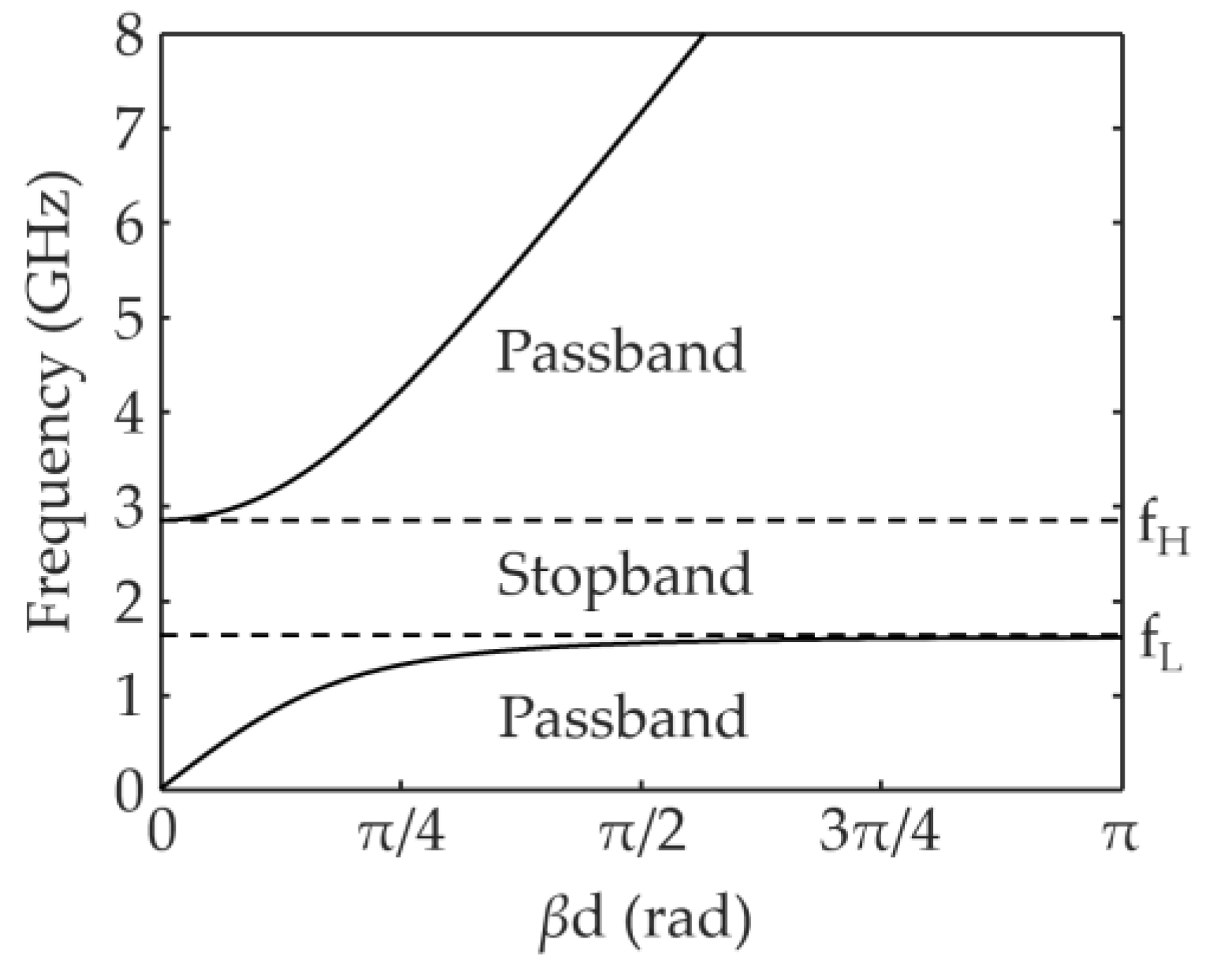
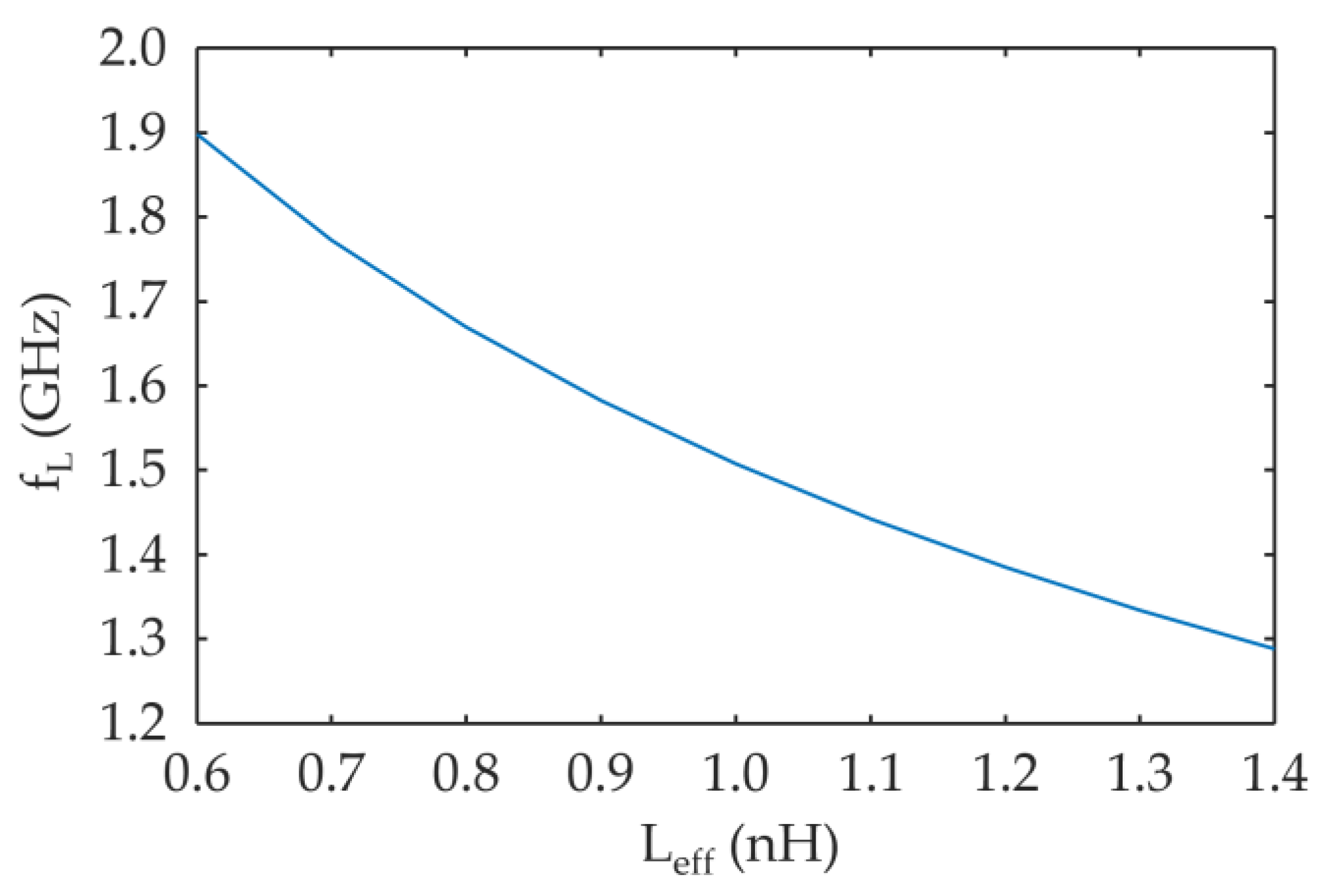
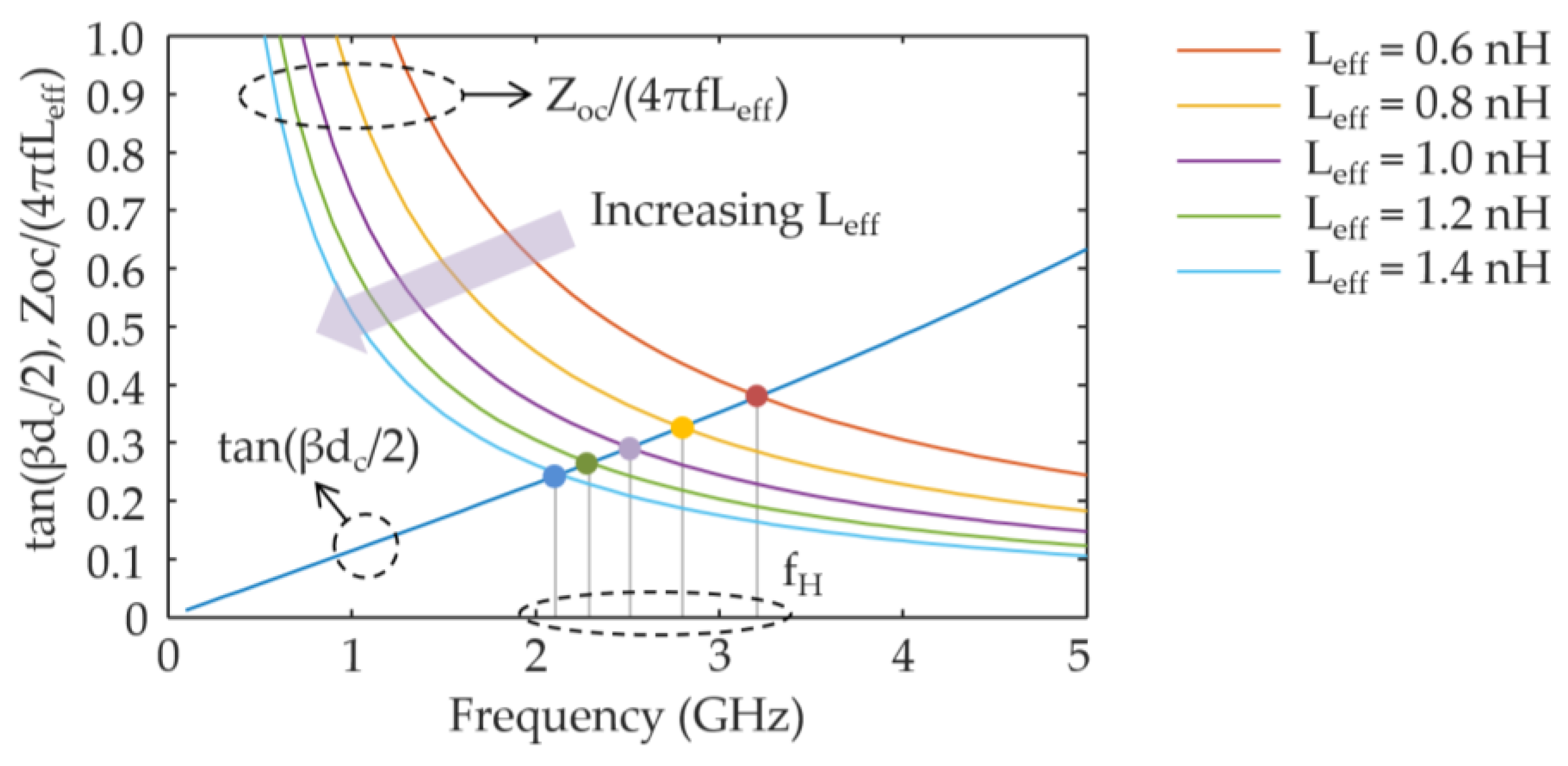
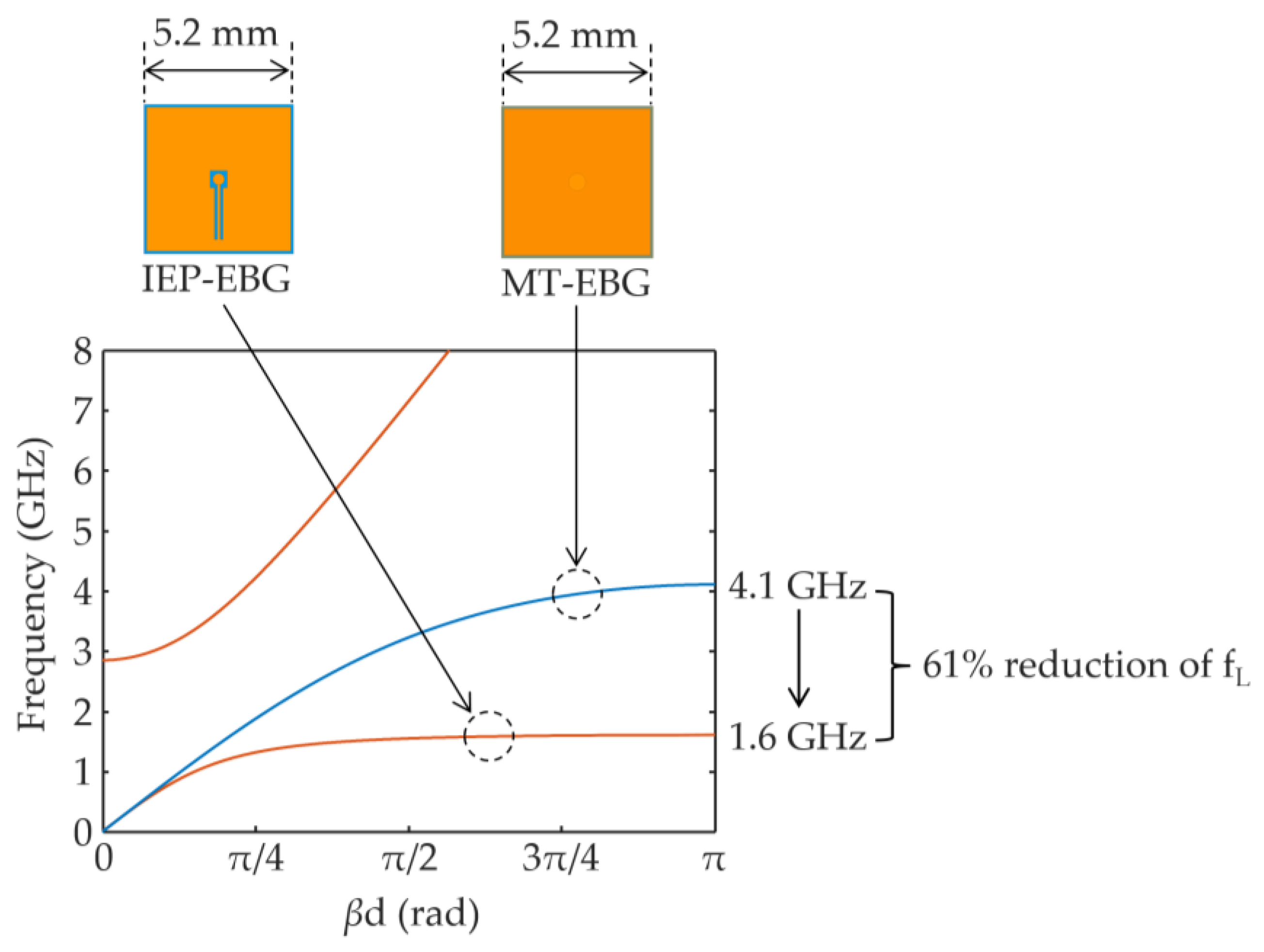
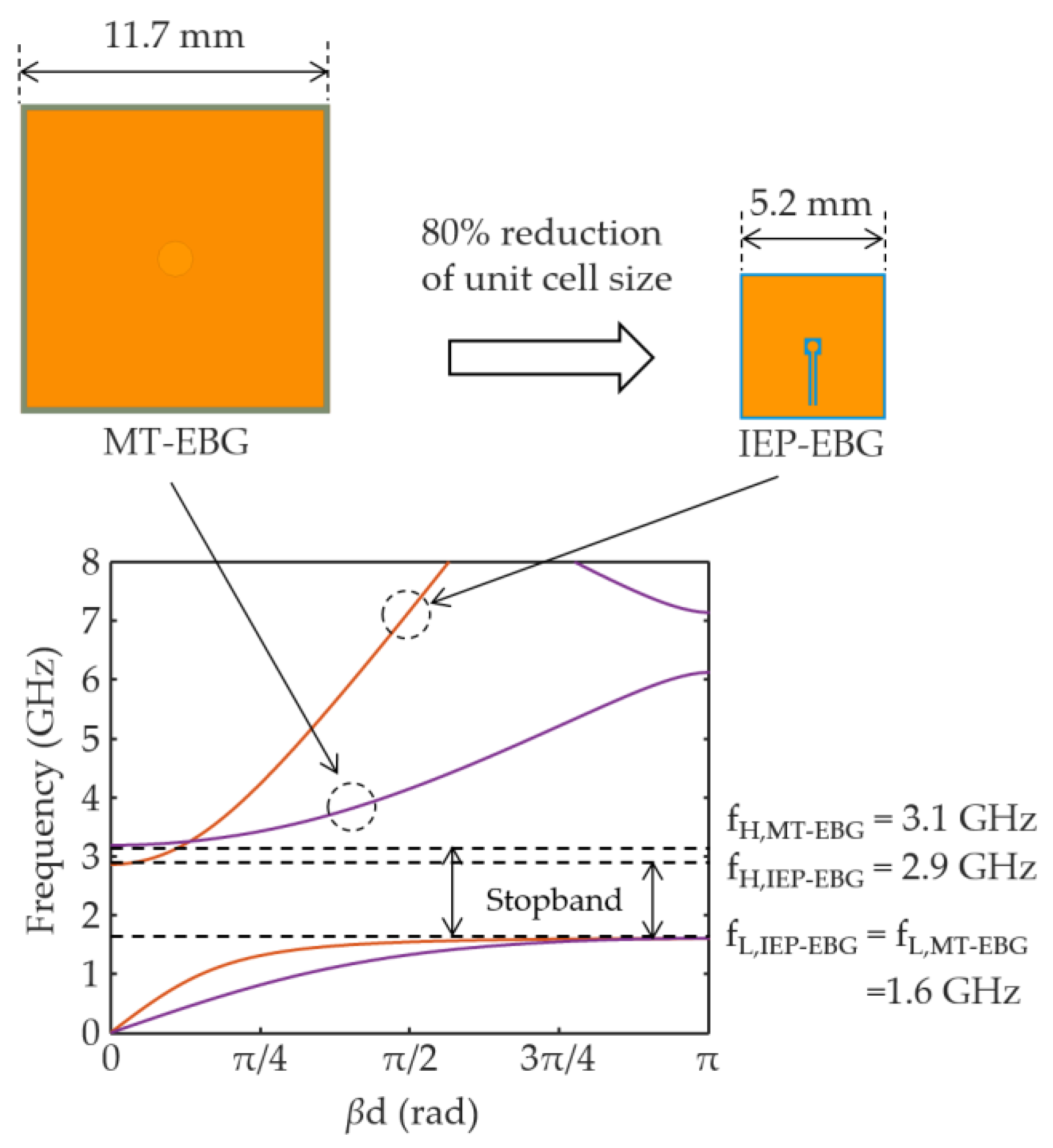




| Parameters | dc | Zoc | Cp | εr | Leff |
|---|---|---|---|---|---|
| Values | 5.2 mm | 9.2 Ω | 10.3 pF | 4.4 | 0.9 nH |
| Parameters | dc | dp | ws | ds | gs | θs | hv | hc |
|---|---|---|---|---|---|---|---|---|
| Values | 5.2 mm | 5 mm | 0.1 mm | 1.8 mm | 0.1 mm | 0 rad | 0.2 mm | 0.3 mm |
© 2018 by the author. Licensee MDPI, Basel, Switzerland. This article is an open access article distributed under the terms and conditions of the Creative Commons Attribution (CC BY) license (http://creativecommons.org/licenses/by/4.0/).
Share and Cite
Kim, M. A Miniaturized Electromagnetic Bandgap Structure Using an Inductance-Enhanced Patch for Suppression of Parallel Plate Modes in Packages and PCBs. Electronics 2018, 7, 76. https://doi.org/10.3390/electronics7050076
Kim M. A Miniaturized Electromagnetic Bandgap Structure Using an Inductance-Enhanced Patch for Suppression of Parallel Plate Modes in Packages and PCBs. Electronics. 2018; 7(5):76. https://doi.org/10.3390/electronics7050076
Chicago/Turabian StyleKim, Myunghoi. 2018. "A Miniaturized Electromagnetic Bandgap Structure Using an Inductance-Enhanced Patch for Suppression of Parallel Plate Modes in Packages and PCBs" Electronics 7, no. 5: 76. https://doi.org/10.3390/electronics7050076




